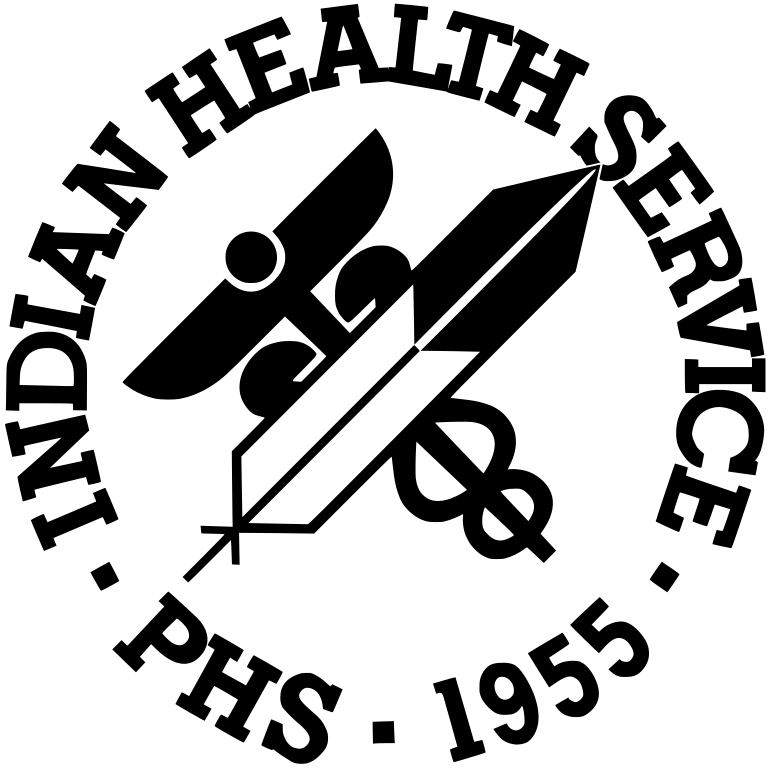ECC Program Spotlight Archive
- Two is too Late... Take the 0-2 Year-Old Open Access Challenge!
- Top Performers in Increasing Fluoride Varnish and ITRs
- Top Performers in Improving Access and Sealants
- Head Start does their Part
- Getting the Word Out = Access
- The ECC Program at Barrow, AK
- ECC program of Hopi Health Care Center
Two is too Late... Take the 0-2 Year-Old Open Access Challenge!
By Dr. Tim Ricks and Dr. Jim SchaefferYou may have heard it before, "Two is too Late", meaning that waiting until American Indian or Alaska Native (AI/AN) children are two years old to have an assessment of their oral health and to receive preventive treatments is often times simply too late. According to Dr. Tim Ricks, the Co-Chair of the Early Childhood Caries (ECC) Collaborative:
The 2010 Basic Screening Survey (BSS) Report showed that 20% of one year-olds and 40% of two year-olds had experienced caries. We believe that getting children to the dentist early is critical to the prevention of ECC and the success of the ECC Collaborative. The key to preventing ECC is to increase access and preventive services to 1 and 2 year-old AI/A children. But 0-2 year-old access has decreased since 2009. We believe that if we don’t have significant and substantial increases in 0-2 year-old access to dental care over the next 2 ½ years, we will not meet the ECC Collaborative goal of reducing ECC prevalence by 25% at the conclusion of FY 2014.
We have challenged dental programs across the country to try open access for just one week. Open access is the ability for parents/caregivers to bring their 1 and 2 year-old children into the dental clinic at any time without an appointment. If this can be done with minimal disruption to normal patient flow, it should be easy to have open access all of the time for 1 and 2 year children. After all, it should take less than two minutes to screen and apply fluoride varnish to a young child (even though you may have to schedule the child for an appointment for sealants and ITRs). We have issued this challenge to spread best practices across all of IHS, tribal, and urban dental programs. Already, we have at least four programs that have stepped up to the challenge. Here are their stories:
1. Hopi Health Center, Arizona/Phoenix Area

The dental staff of Hopi Health Center
They have had "open access" (exams) for over the past 7 years.How they did it:
They spread the "open access" message to the Tribal Governing Board, to WIC, and others… which resulted in the message of "open access" being spread by word-of-mouth in the community.Results:
They had a continuous, 7-year increase of 34% in the number of 0-6 year-olds accessing dental care, and an increase of 33% in the number of 0-6 year-old exams.What's up next:
Continue open access.Point of contact:
If you want to know more ask Dr. Mary Beth Johnson: MaryBeth.Johnson@ihs.gov.
2. St. Regis Mohawk, New York/Nashville Area

Ms. Elaine Castor, Dental Assistant
They promoted 0-2 year-old access to key champions such as their WIC Coordinator, the nurse practitioners, and the pediatrician in their clinic.How they did it:
They bought a molar cup (low cost) to give as an incentive to these champions.Results:
Baseline week 5-21-2012= 1 patientWhat's up next:
Open Access week 6-4-2012= 28 patients
They are going to continue the program as it is now.Point of contact:
If you want to know more ask Dr. Joe Park at jpark@regis.nashville.ihs.gov.
3. Cherokee Indian Hospital, North Carolina/Nashville Area

Ms. Donna McCracken, dental assistant, Dr. Joyce Biberica,
Ms. Mellie Burns, public health hygienist who oversees the
Children's Dental Program, and Ms. Pam Cooper, dental assistant.
Sent out a hospital-wide e-mail talking about the program, and posted signs throughout the hospital.How they did it:
Spoke with the hospital Public Relations Director to have an e-mail sent out, and poster and signs printed.Results:
During their one-week 0-2 year old Open Access Challenge:What's up next:
Baseline week = 0 patients
Open Access week = 10 patients
They are going to continue the program and will post signs in the pediatric department's exam rooms.Point of contact:
If you want to know more ask Dr. Joyce Biberica: joyce.biberica@cherokeehospital.org.
4. Choctaw Health Center, Mississippi/Nashville Area

Choctaw Health Center.
They developed a flyer to advertise the Open Access Challenge.How they did it:
They e-mailed the flyer out across the community to promote “open access”.Results:
During their one-week Open Access Challenge, they went from 37 to 41 0-2 year-olds, a 10% increase.What's up next:
They are going to look into running patient lists (they have almost 800 0-2 year-olds) and have a staff member attempt to reach these children ... case management!Point of contact:
If you want to know more ask Dr. Brian Berg: Brian.Berg@ihs.gov.
Some common themes or best practices are evident throughout each of these successful dental program stories. They are:
- Open Access/Removing Appointment Barriers. Dental programs rely on an appointment structure to most effectively deliver quality oral health care to patients. However, this system is often a barrier to reaching young children who may be in the health clinic for a medical appointment, and whose parents may not wish to schedule a dental appointment for one reason or another. Dental programs that have been successful at increasing 0-5 year-old access have implemented open access or same-day appointments to remove these appointment barriers.
- Local Champion. Identifying a local champion is another common characteristic of successful programs. In most cases, the local champion – the one who continues to emphasize ECC prevention to the dental team, collaborative partners, and to the community – is a member of the dental staff, but there are some local champions that are non-dental staff, such as public health nurses. Regardless of who the champion is, identifying someone to have the passion, energy, and enthusiasm to promote ECC prevention continuously seems paramount to the success of the ECC Collaborative.
- Case Management. Dental programs that have the most success with the ECC Collaborative process objectives have had some type of case management being performed. The term “case management” is loosely defined as anything from running patient lists before doing a community activity to determine who needs dental care to maintaining a spreadsheet and following up with patients and parents on a weekly basis to ensure that the child is receiving all of the preventive services.
- Medical-Dental Collaboration. Dental programs that have had success in increasing access to care, especially for 0-2 year-olds, have reported strong medical-dental collaborations. Such collaborations have resulted in medical provider application of fluoride varnish and oral health assessments as well as increased dental staff presence to conduct screenings and fluoride varnish applications during the medical well-child clinic day.
- WIC and Head Start Collaborations. While Head Start – dental program collaborations are long standing, the ECC Collaborative seems to have strengthen these collaborations. Dental programs are reporting increased dental services in the Head Start Centers, including exams, sealants, fluoride varnish applications, and even ITRs in some cases. Several dental programs have reported new collaborations with WIC, with at least one Tribe even requiring parents to have their children examined in the dental clinic before they can receive WIC benefits.
Most successful programs are using a combination of best practices to achieve increased access!

So now comes the challenge... the 0-2 Year-Old Open Access Challenge. Are you ready to take the Challenge? Which of these best practices is your clinic ready to adopt?
We encourage you to take the Challenge and get started increasing 0-2 year-olds access and preventing Early Childhood Caries in our AI/AN population.
Top Performers in Increasing Fluoride Varnish and ITRs:
What they did and how can we learn from them?
By CAPT Jim Schaeffer, Deputy Director, IHS Division of Oral Health
Remember in the ECC Collaborative we are seeking to reduce the overall occurrence of ECC by 25% or more in 0-5 year olds. This will be accomplished by increasing access to care, placing sealants, applying fluoride varnish treatments, and providing interim treatment restorations. Last quarter our Spotlight article dealt with increasing Access and Sealants for 0-5 year old children. This quarter we want to focus on Top Performers applying Fluoride Varnish (both in the dental clinic and in the medical clinic) and providing Interim Treatment Restorations to 0-5 year olds. Here are the stories of Top Performers from the first year of the ECC Collaborative.
Fluoride Varnish Applications: 0-5 Year Olds in the Dental Clinic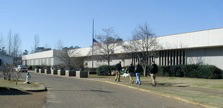
The Choctaw Service Unit (Nashville Area), where Dr. Brian Berg is the Chief of the Dental Program, increased the number of fluoride varnish applications in the 0-5 year old age group by 250.
According to Dr. Berg:
"This was accomplished by planned collaboration with the Tribal Head Start Centers and the Choctaw Tribal School Program. In the past we used to administer a fluoride rinse program at all tribal schools. This year was the first time our three Choctaw Health Department dental hygienists worked together to schedule and provide fluoride varnish applications three times a year to all tribal school students. This included pre-K and Kindergarten students. The hygienists also planned into their schedules visits to tribal Head Start Centers to apply fluoride varnish, so that it was more consistent than previous years."
Last year at the Blackfeet Service Unit (Billings Area) they were able to increase the number of fluoride varnish applications by 196. Dr. Gary Pannabecker, the Chief Dentist at the service unit explained how:
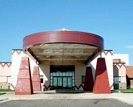
"A dental assistant (DA), a dental hygienist(DH) , and I went to the Early Head Start Center two times per week during the school year and provided screenings and fluoride varnish as usual, but also did Interim Therapeutic Restorations (ITRs) in that setting to children with appropriate lesions. The DH and DA go more frequently for fluoride varnish (fv). We provided staff training so all staff were on board… …gradually staff dentists provided more (fv and ITRs) in the clinic, also."Fluoride Varnish Applications to 0-5 Year Olds in the Medical Clinic
One of the Top Performers in fluoride varnish applications in the medical clinic was the Pine Ridge Service Unit (Aberdeen Area) where CDR Delores Starr, a Dental Hygienist, was responsible for planning the training of the medical staff. Her efforts resulted in an increase of 124 fluoride varnish applications compared to the previous year. CDR Starr reported:
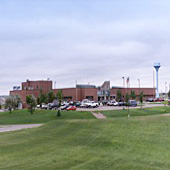
"We did training with the medical staff on fluoride varnish (fv) along with the billing process. We also wrote the standing orders for them and had them in place in each clinic. We provided the fv to each of the field health nurses and they applied it in the field clinics during immunizations … this was our best resource. I called this project the Paint to Prevent Project and did it throughout the whole Aberdeen Area. They all did a great job. I also wanted to add that there is one specific field health nurse that did most of the fv’s. Her name is Mary Mousseau and along with the fv’s she distributed sippee cups as an incentive and gave great oral hygiene instructions."Interim Therapeutic Restorations in 0-5 Year Olds
Interim Therapeutic Restorations (a.k.a. Mighty Mouth Fillings) are one of only two interventions of the ECC Collaborative which are only placed by dental staff (the other is dental sealants). The Tuba City Dental Clinic (Navajo Area) was able to be a Top Performer by training ALL of their dentists how to use glass ionomer (GI) and how to correctly code these procedures at the start of the ECC Collaboration. Dr. Bruce Craig, Pediatric Dentist at Tuba City said:

So the Top Performers revealed some secrets to increasing the numbers of Fluoride Varnish applications and Interim Therapeutic Restorations – basically it comes down to good collaboration with our medical and community partners and thorough training of everyone involved in this collaboration.
For our next article we will feature one Service Unit that is using social media to get the word out about prevention of ECC to their patients or their families.
Top Performers in Improving Access and Sealants:
What they do and how can we learn from them?
By CAPT Jim Schaeffer, Deputy Director, IHS Division of Oral Health
The IHS Early Childhood Caries (ECC) Collaborative depends on collaboration with medical and community partners to get access to and to provide preventive services for the youngest members of the populations we serve. At the IHS Update 2011 Conference Dr. Tim Ricks recognized the first year Top Performers. He pointed out that our 0-2 year old patients are rarely seen in the dental clinic, but they often have decay. I talked with some of the Top Performers to learn how they gained access to both 0-2 year olds and 3-5 year olds. Here are their stories.
Improving Access to Care for 0-5 year-olds

The Choctaw Service Unit located in Mississippi (Nashville Area) increased access to care in 0-2 year-olds through a collaborative program with the Women’s, Infants’, and Children’s (WIC) Program. Dr. Brian Berg, Chief Dental Officer at Choctaw, said that working with WIC and other community partners was the key to their success for reaching 0-2 year-olds:
"When mothers bring their children in for WIC vouchers, they first have to bring their children over to dental for an exam or screening. This past year, this collaboration was more effective than in previous years. We also work with Early Head Start and Daycare Centers on the reservation providing exams for all those children. Because of these working relationships, our service unit was able to increase the number of 0-2 year olds seen by 111 over the baseline.
Similarly, the Fort Peck Service Unit (Billings Area) was able to increase access to dental care for the 0-2 year old children by not only collaborating with the WIC program but also with the medical clinic. Ms. Marsha Larrabee, RDH, explained the program:

We were able to start including a dental screening, fluoride application, and parent oral health education component to the regularly scheduled well-child clinic at both medical clinics. One morning a week in each clinic the community dental hygienist goes into the medical clinic and is part of the clinician rotation seen by each child during their well-child visit. In addition to the well-child program, the community dental hygienist routinely works with the WIC program in Wolf Point to provide dental screenings and fluoride varnish to children referred from the WIC staff. This portion of the program is facilitated by the fact that the hygienist’s office is in the same hallway as WIC and the public health nurse. Parents know where to go to find ‘the fluoride lady’ and they do not have to negotiate the dental clinic reception area.
In the 3-5 year-old age group, two programs stood out in increasing access to care. At the Acoma Canoncito Laguna (A-C-L) Service Unit (Albuquerque Area), access to care in 3-5 year-olds increased by 191 in the past year. Dr. Alan Tatz, Chief Dentist, explained how they did it.

We did our screenings differently than previous years. We also collaborated with the schools and school boards to reach the children, and we involved our entire dental staff, sending all members to school sites for screenings and fluoride treatments. We received a Health Promotion/Disease Prevention Program Award last year and used the monies to purchase portable dental equipment. This allowed our dental staff to go to the area schools or Head Start centers and screen the children there, and we are able to see more children in a shorter amount of time. The children do not have to leave the school and are out of class for only minutes instead of hours.
Another Top Performer for improving access to care for 3-5 year olds was the Rosebud Dental Clinic in the Aberdeen Area. “We have a staff that has been supportive of one another and who have pulled together to accomplish the goal of getting families involved with dental care for themselves and the community” said Dr. Vernetta Hodge, Acting Dental Director.

The mission of the Rosebud Dental Clinic is to serve Lakota families and patients across three counties: Tripp, Todd, and Mellette County. Our dental approach has been an outreach to the Women, Infants, and Children (WIC) program, the 15 Head Start Centers in the Rosebud area, and the school-based sealant application program. We put children first. Also, our hygienist, Doretha Wilson, and our dentists, Dr. John Graf and Dr. Leigh Wilson, provided public service announcements, discussing dental care and the importance of early intervention that aired daily on the KIN radio station in our area.
Increasing Dental Sealants in 0-5 year-olds
A second goal of the ECC Collaborative is to increase the number of sealants placed in the 0-5 year old population. I spoke with two Top Performers to learn how they made dramatic improvements. At the Sisseton Service Unit (Aberdeen Area), Dr. John Zimmer, pediatric dentist, explained how it took a commitment by leadership and community collaboration.
The placement of sealants for very young children (children less than five years old) is affected by several activities. First of all, the clinical supervisor is committed to addressing caries prior to significant occlusal cavitation. Secondly, individual training was provided to auxiliary personnel regularly. Finally, the glass ionomer sealants were seen as a viable alternative to resin sealants for this age group. The opportunities to place sealants have increased due to:
- Collaboration with community-based prevention activities. It was essential the community-based personnel not only know of the interventions, but witness the placement of glass ionomer sealants for very young children. The resulting testimonials started the friend-to-friend referral system.
- During sealant applications, parents assist in the knee-to-knee process. They witness the ease and learn about the potential benefits of sealants for young children.
The Chinle Service Unit (Navajo Area) was another Top Performer for sealants:

An educational process ensued whereby dental staff were reminded of the clinical importance and renewed focus on fluoride varnish, sealants, and the use of Interim Therapeutic Restorations (ITRs) to combat the epidemic of ECC. Subsequently, a lunchtime CME on the ECC Collaborative was presented by the Dental Department to the Medical and Pediatric Staff, Public Health Staff, Nursing Staff, and other stakeholders at the Chinle Service Unit. The contents of the ECC packet were used as handouts, and the message was focused on the 0-5 age group, with particular emphasis on the younger ages. The preventive use of fluoride varnish, ITRs, and sealants was emphasized, along with the need to refer children to the dental clinic before age 2. Referrals subsequently increased, and we were fortunate as dental staffing levels allowed for increased access for this vulnerable population.
I would like to emphasize how many of the Top Performers identified the key to their success in improving access to care and the number of dental sealants for 0-5 year-olds was collaboration with their medical and community partners. In the next Spotlight article, we will look at other Top Performers and how they achieved success in applying fluoride varnish and placing Interim Therapeutic Restorations or "Mighty Mouth Fillings."
Head Start does their Part
Head Start’s Role in the ECC Initiative
By Dr. Bonnie Bruerd
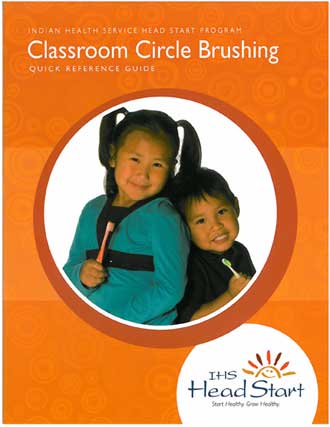
The Indian Health Service (IHS) Head Start Program has been involved as a partner in the national ECC Initiative from its early stages. Head Start has the difficult job of getting dental exams and dental treatment completed on these children, and so Head Start staff understands the importance of focusing on the primary prevention of dental caries. Head Start was first funded in 1965 and is divided into geographical region with one of the exceptions being Region XI, which serves over 25,000 American Indian and Alaska Native (AI/AN) children through about 600 centers in 26 states.
In 2007, the IHS Head Start Program developed an “Oral Health Toolkit”: a packet of oral health materials that includes “Best Practices” and “Tools and Resources” to improve the oral health of Head Start children and their families. The toolkit also includes a document on “informed consent” that allows Head Start to transport children to the dental clinic for routine dental treatment, as long as informed consent has been achieved with the parents. There are also parent materials, a poster, and a guide to encourage circle brushing in the Toolkit.
In 2009, the Head Start Program, in collaboration with IHS medical and dental consultants, developed an online course “How to Apply Fluoride Varnish” that is targeted to Head Start and medical staff who want to learn how to apply fluoride varnish. The course concludes with a posttest and a certificate upon successful completion, along with a form for standing orders that needs to be signed by a local physician or dentist who will oversee the Head Start staff. Additionally, the IHS Head Start Program has presented this course at Head Start cluster trainings and national conferences. In 2010, the IHS Head Start Program purchased 20,000 doses of fluoride varnish which are currently being distributed to Head Start programs that have successfully completed the training.
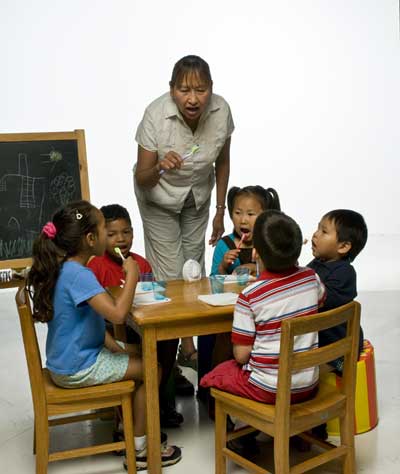
One of the biggest obstacles to getting dental treatment completed for Head Start children is a lack of parent involvement. We recently developed parent materials for both Early Head Start and Head Start families; along with bracelets that Head Start can place on children’s wrists to remind parents of upcoming dental appointments. Head Start struggles to get dental treatment completed on these children each year. The dental programs can help Head Start by meeting with them in the summer to discuss dental access, blocking out times for Head Start exams and dental treatment, and providing more sealants and treatment with Interim Therapeutic Restorations (ITRs - glass ionomer restorations) to avoid expensive and difficult referrals.
Head Start is involved in daily brushing at school with fluoride toothpaste, 3-4 applications of fluoride varnish yearly, family education, and the provision of yearly dental exams and dental treatment for those children in need. Head Start is a committed partner in the national ECC Initiative. Won’t you be too?
For more information on the IHS Head Start Program, go to our website: Head Start Program Website
Getting the Word Out = Access
By CAPT Jim Schaeffer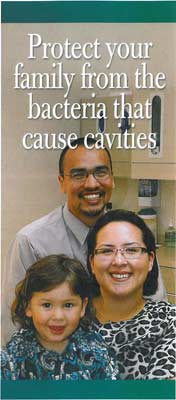
Some of the local Dental and Health Clinics may be wondering how to advertise or market the Early Childhood Caries Initiative among the families that have the most to gain from the program? In our last report, I told how the Dental staff in Barrow, AK was “at nearly every event in town with our clown suit, tooth suit, or walrus brushing costume.” I came across a few other examples of enthusiastic clinics in working with the “ECC Spotlight” that I would like to share in this report.
The first example is the Southeast Alaska Regional Health Consortium (SEARHC) with Dr. Kim Hort, D.M.D. (kim.hort@searhc.org) as the Pediatric Dentist and Dr. Tom Bornstein, D.D.S. (tom.bornstein@searhc.org) as the Dental Division Director. Dr. Hort reported on the local ECC Program already in existence at SEARHC: “A Dental Health Aid is a part of the Obstetrics rounds in the medical clinic. She provides oral health education to the expecting family, as well as schedules a dental exam for expecting mothers. Perinatal mothers (and partners) are educated about the transmissibility of oral bacteria, importance of their own oral health, and oral health prevention strategies for their newborn. Most of this information is delivered face-to-face, although we also have the information in a color printed brochure. (See image)
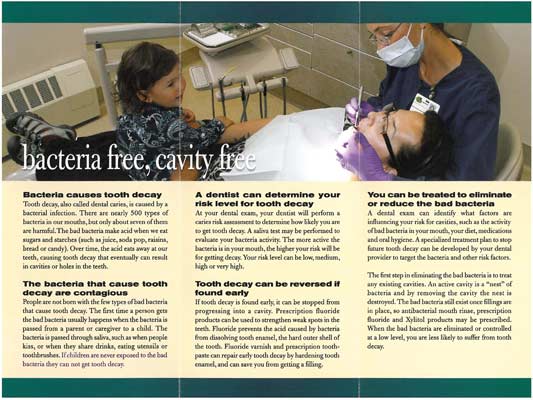
“The first dental exam is scheduled from that encounter in the medical clinic, which eliminates the barrier of the patient calling and struggling to make that first exam appointment,” said Dr. Hort. “In addition, patients are regularly referred to the dental clinic by pediatricians, family physicians, and our other partners at WIC, Head Start and other community groups. The goal of treatment is to complete any caries stabilization within two months and then begin therapies to reduce the oral bacterial load with interventions, including chlorhexidine, povidone iodine, and a prescription dentifrice. A check is then done to assess effectiveness of the therapies to reduce bad oral bacteria and, provided they have been effective, permanent restorations are then completed.”
“Our dental health aids are able to pull information from our electronic record and track patient appointments, missed appointments, and progress along the way to oral health. In the past 6 months, the pediatric program has entered caries risk assessments for 99% of the patients seen, and 85% of the children had caries stabilization completed. In recognizing our barriers and successes, we realized that we needed to keep it simple in order to keep all staff on board. Our vision is to standardize our protocol so that it can be easily utilized clinically,” said Dr. Hort about the SEARHC’s ECC Initiative.
The second example is from the Parker Indian Health Center (IHC) in the Phoenix Area where the Chief Dental Officer is Dr. Heather Judd, DDS (heather.judd@ihs.gov). “The Parker IHC plans to advertise their ECC Initiative with a Public Service Announcement to be played at the local movie theater” said Dr. Judd.
“Our other plans include a television interview, with Dr. Randy Smith (randall.smith@ihs.gov), our pediatric dentist, and me, and a radio interview with the two of us. We are also going to have a series of articles in the local newspapers and in the monthly community newsletter. We had informational brochures printed to distribute at screenings and health fairs, and the pharmacy is distributing these brochures along with medications. Public Health Nurses are providing education and referring mothers and expectant mothers for screenings. Dental staff is providing education in the schools, Head Start, WIC, parent teacher nights, and any other event where they are invited. Randy Smith is working with Maternal Child Health to provide education and screenings for expectant mothers,” she reported.
“Dental screenings and Fluoride varnish are currently being done by the dental staff at Head Starts and health fairs. WIC and Well Child staff are sending parents with small children to the Dental Clinic any time we are open, and they will be seen immediately for screenings and/or fluoride varnish applications. The pediatrician is applying varnish, as well as referring the families to the Dental Clinic. We are beginning to see a pay-off in oral hygiene and more willingness to come in for recall visits”. Dr. Judd added that “with media bombardment, increased education, and easy access, I predict an overall improvement over the next few years”.
The ECC Program at Barrow, AK
By CAPT Jim Schaeffer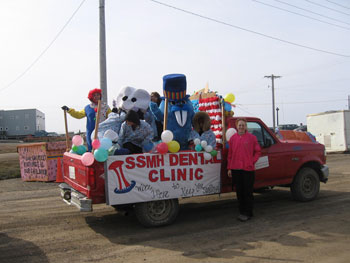
The IHS dental clinic in Barrow Alaska has the distinction of being situated further north than any other clinic in America. It is located in the Samuel Simmonds Memorial Hospital, and currently has 3 full time dentists and one vacant dental position. Dr. Amanda Gaynor Ashley has been the Chief Dentist of this tribally run Dental Clinic for the past 9 years, after working for 2 years as a Staff Dentist also in Barrow. I had the occasion recently to talk to her regarding the clinic and the ECC Program they have in place there. “We have a kids clinic Monday through Friday 3-5 PM when parents can book appointments for their children,” she said, “We place all children on 3 month recall status and send a post-card to remind their parents of upcoming recalls. The postcard gets them “first dibs” in the appointment book, and we usually appoint 5 to 8 kids per afternoon for each dentist.”
“For the kids that are age 0-5 years old, we do a knee-to-knee exam with the caregiver, a “toothbrush prophy”, Oral Hygiene Instruction (targeted with anticipatory guidance), and topical Fluoride varnish. For those that need more treatment (sealants or interim treatment restorations) we do either Optibonded Sealants when we can get moisture control, or Fuji IX Extra (Glass Ionomer), when the kids are less cooperative. We also access the 3-5 year old children at the school where we do a quarterly Oral Hygiene presentation, and at the Boys and Girls Club of Barrow for an every other month Oral Health presentation and pizza party. In addition, during our annual sealant clinic, we bus kids from their schools and provide parents with information on ECC and the benefits of sealants (stapled to their sealant clinic consent form)” said Dr. Gaynor Ashley.
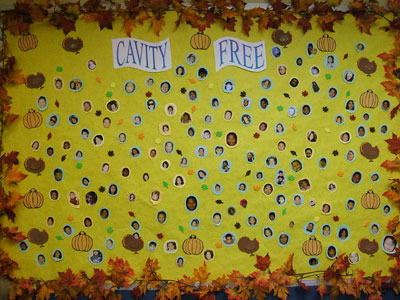
I remarked that what seems to be unique to the program at Barrow is the many unique ways they reach out and engage the children of every age. Dr. Gaynor Ashley said that “We have no toy store in Barrow, so a big draw is our huge overflowing prize box. We are also at nearly every event in town with our clown suit, tooth suit, or walrus brushing costume. Some examples are the 4th of July parade, Rotary Carnival, football games, and the diabetes run, etc.” She said, “They used to do a quarterly radio program for my first 9 years in Barrow, but they’ve changed station managers and we haven’t been able to do that for the past two years.”
Unfortunately, Dr. Gaynor Ashley will be leaving her position as Barrow’s Chief dentist on June 17 to begin a pedodontic residency at Ohio State. She plans on returning in 2011, however, to make use of the $115,000 she earned last fall from the Robert Wood Johnson Foundation Community Health Leadership Award. She will lead a pedodontic specialty team, comprised of her Ohio State pediatric faculty and fellow residents, back to Barrow for Children’s Dental Health Month to provide specialized services. When I asked Dr. Gaynor Ashley if the dental team saw any positive results for all of their efforts, she remarked “We hardly see any children in the emergency clinic now that we’ve put these practices in place for at least the past 6 or 7 years. That definitely makes it worth the effort.” Dr. Amanda Gaynor Ashley can be reached for questions by email at agaynor100@hotmail.com, and Dr. Kimlea Medlin, her deputy, who will be taking over as Dental director when she leaves, can be reached at kimlea.medlin@arcticslope.org.
Hopi Health Care Center
To roll out our initiative, we felt that it is important to acknowledge programs that already have, in place, a program to give broad access to the 0-5 year old age group with information, prevention, and early intervention. Each quarter we will pick a program, which we are aware of, that exemplifies the cooperation necessary to a successful ECC program. We will highlight the program here on the homepage and describe what is unique about the program. In this way, we believe you can learn from other Sites how they have implemented an ECC program.
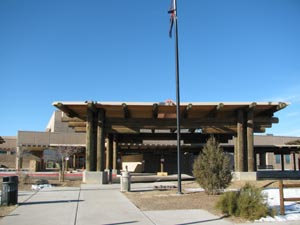
The inaugural program is the ECC program of Hopi Health Care Center, which is coordinated by Lori A. Goodman, RDH, MPH, who is a Commander (CDR) in the US Public Health Service, and serves as the Periodontal Disease Prevention Officer. “I have been here three years”, says Lori, “The Community Health Representatives (CHR) and the Public Health Nurse (PHNs) program are new this year; the Women with Infant Children (WIC) and the Baby Face programs were started last year; and the Head Start program was in place when I got here, but has evolved over the three years”. The program also involves the Well-Child Clinic. “What we have noticed in the short time of the program’s existence, is that the children are being seen sooner instead of when the pain kicks in. We have much better follow up to completed treatment with head start, and we have noticed that the community is much more aware of what age a child should visit the dentist by.” What is unique to this program is the collaborative effort involving the entire health and child care team.
CDR Goodman directly oversees the Head Start programs and the Baby-Face programs. Every year Head Start holds a “Mass Screening” for Early Head start and Head start children, and the Hopi Health Care Center dental program sets aside time at the clinic for head start programs to bus in their kids for exams, cleaning, sealants, and fluoride. Oral health information is provided, topics addressed include: healthy snacks, lift the lip at home, tooth brushing and flossing instructions, tooth eruption information, when to visit the dentist, and ECC information. Quarterly fluoride varnish applications and oral health information are also provided to all head start programs on Hopi. Fluoride is part of the preventive visit when the children are bussed to the clinic. The Baby-Face program is for 0 to 3 year old children. All of these children are provided an oral health screening by a dental hygienist and fluoride is applied. A presentation is given for this program for parents/caregivers of 0 to 3 year olds which focuses on ECC, child’s first visit to the dentist, lift the lip at home, and oral hygiene instructions. All data on treatment is entered into the Resource and Patient Management System (RPMS).
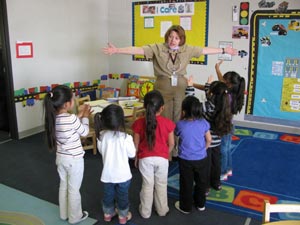
Presently the PHN and CHR program is coordinated by Lieutenant Junior Grade (LTJG) Diane Weidley, RDH, BASDH, who provides the training to identify dental caries based on a visual screening. The PHN’s and CHR’s make home visits, during which all children are screened for dental problems. Parents are given information on how to access the dental clinic at Hopi Health Care Center and an Oral Health Kit based on the child’s age. The infant package, for example, provides information about ending the use of a baby bottle by one year of age, first dental visit by one, why moms should visit the dentist while pregnant, eruption charts and oral health tools such as a tooth tender, chewing toy with bristles, and pacifiers. The PHN’s and CHR’s provide LTJG Weidley with a copy of the Patient Care Component (PCC) for the home visit for tracking in the RPMS.
The Well-Child Clinics and the WIC program is coordinated by CDR Mary Beth Johnson, DDS, MS. “All children are screened for oral health problems while at their well-child check up appointment with medical. The dental clinic is in the same hospital as the well-child clinic and referrals are made by the medical folks,” explained CDR Goodman. Medical staff are provided oral health updates and training for screening, fluoride application, patient information, and RPMS documentation. The WIC staff are provided training on how to recognize ECC and provide an oral screening when the parents bring in their children. The WIC office and the dental clinic are both located in the hospital so referrals to the dental clinic are easily made. If the mother is pregnant, the staff remind her to be seen at dental while she is pregnant, and parents are told to bring their children in by age one. Information is provided about accessing the dental clinic along with bacterial transfer from mom to baby, nutrition, and ECC.
CDR Goodman would like to mention that these programs would not be possible without the dedication and commitment of Dr. Claudia von Hendricks to Indian communities. She was the Chief of the Dental Program at the time that these programs were developed and implemented. Hopi Health Care Center, is located in Polacca, Arizona. Dr. Jeffrey Carolla is currently the Chief of the Dental Program and it is part of the Phoenix Area. CDR Lori Goodman can be reached by email at lori.goodman@ihs.gov .
References:
- National Maternal and Child Oral Health Resource Center. Promoting Awareness, Preventing Pain: Facts on Early Childhood Caries (ECC). 2004. Available online at www.mchoralhealth.org.
- American Academy of Pediatric Dentistry. 2008. Full definition available online at www.aapd.org.
- Indian Health Service, U.S. Department of Health and Human Services, 2000. The 1999 Oral Health Survey of American Indian and Alaska Native Dental Patients: Findings, Regional Differences and National Comparisons, Rockville, MD: Indian Health Service.
